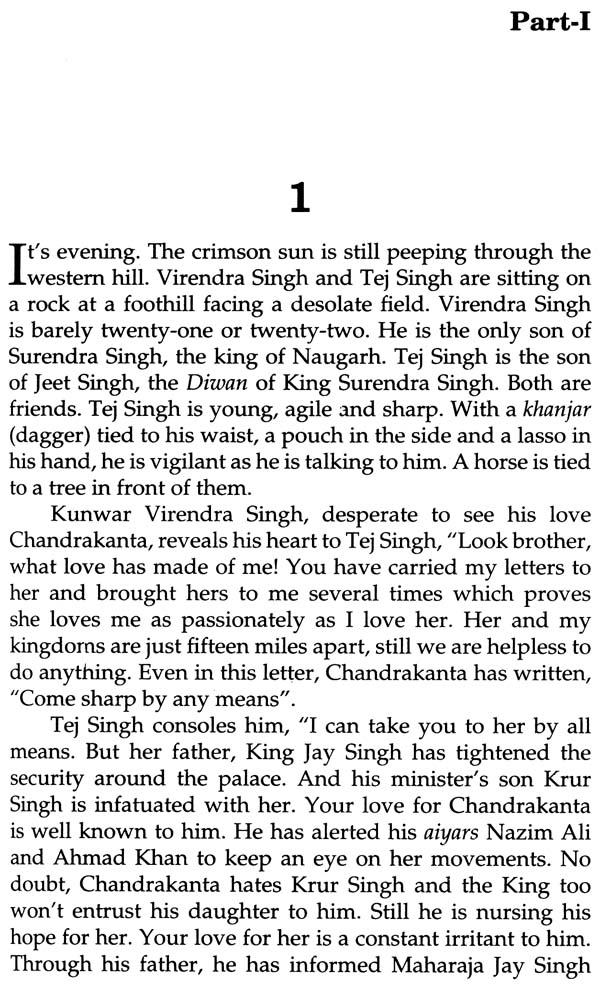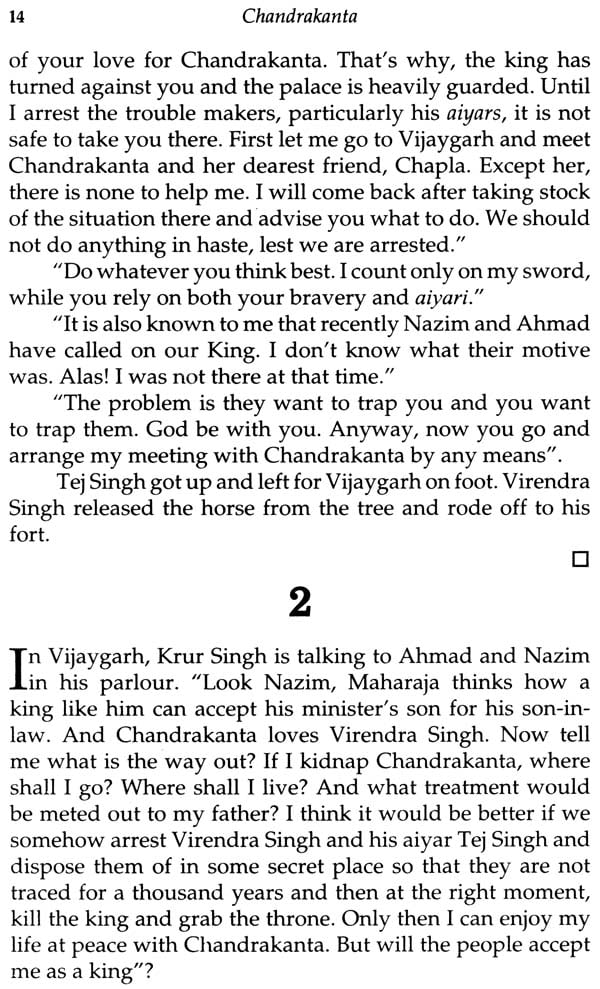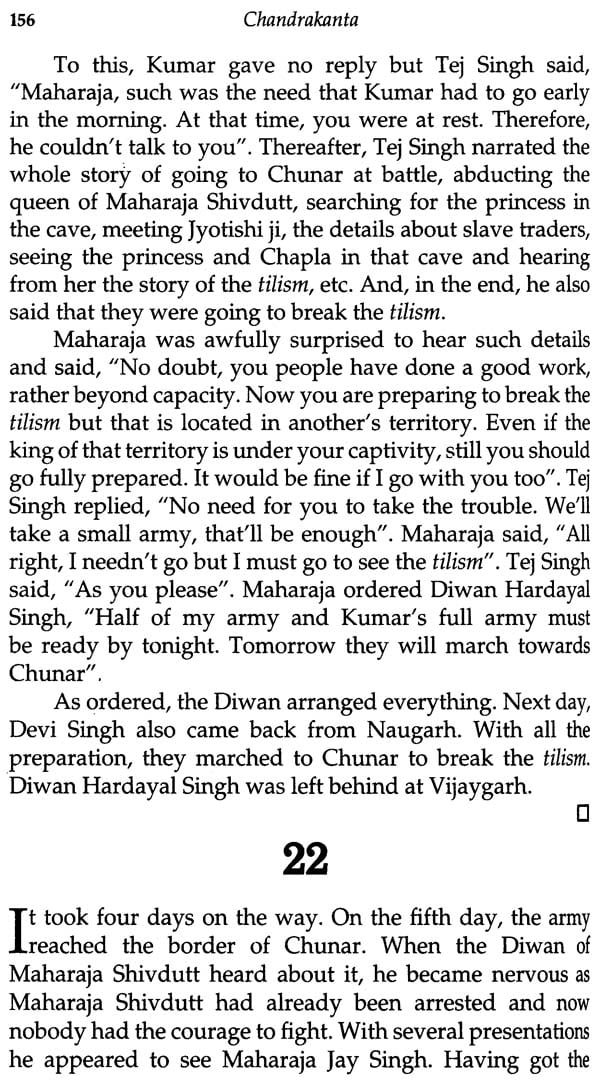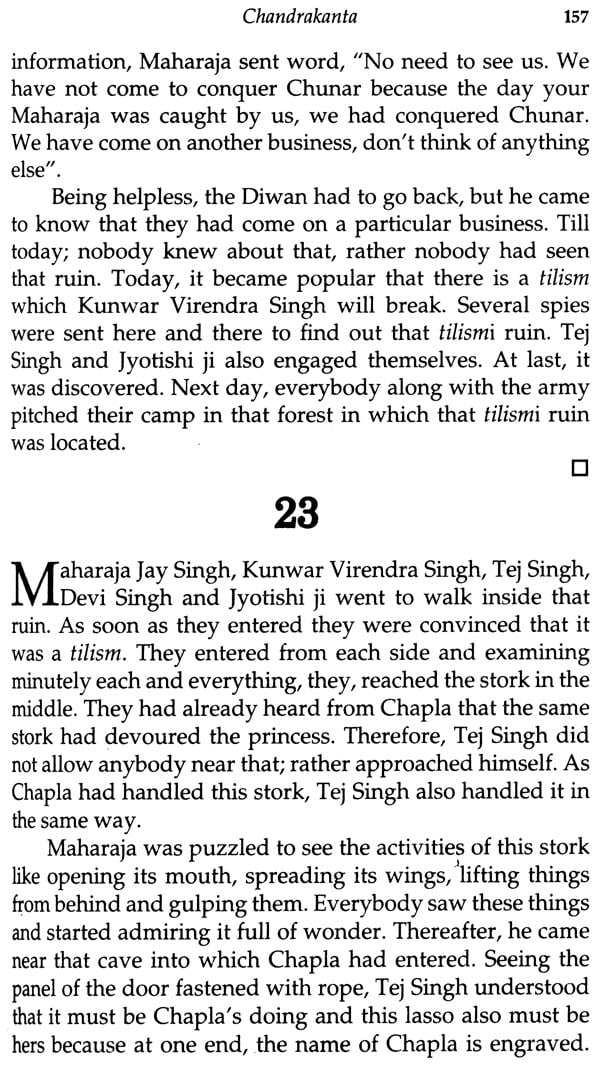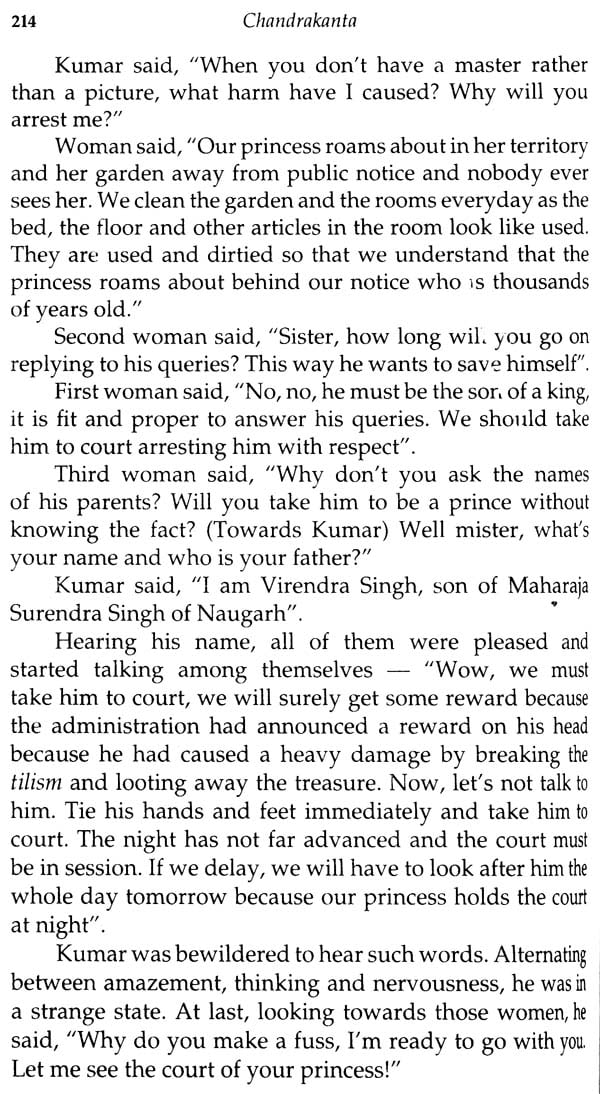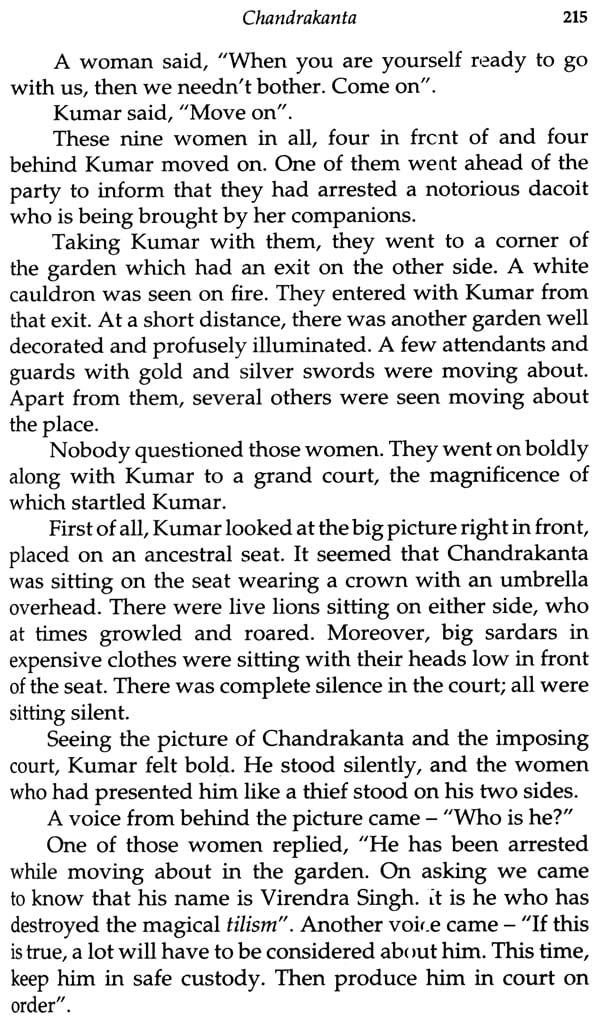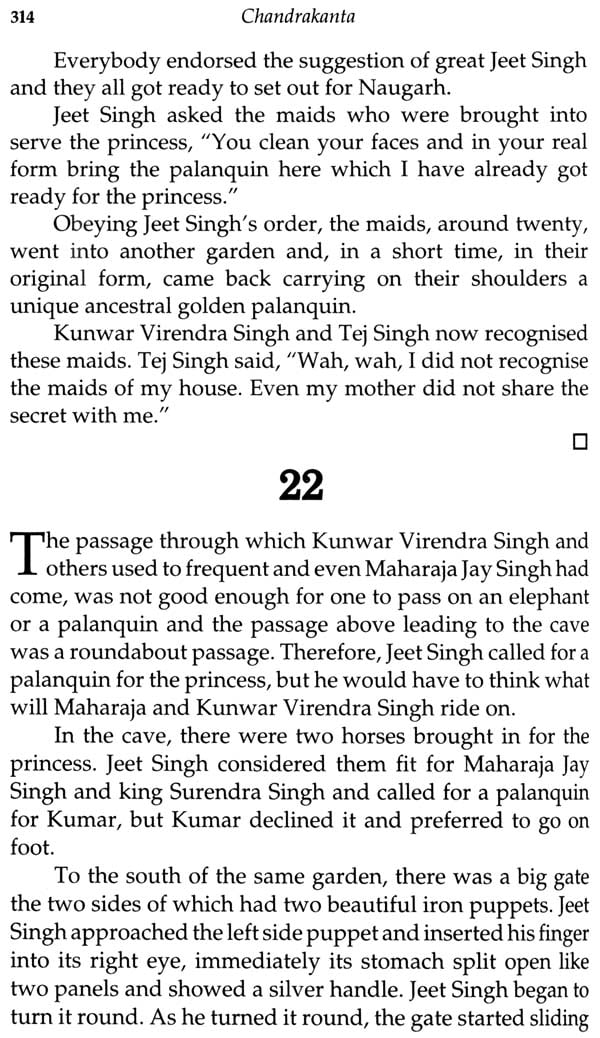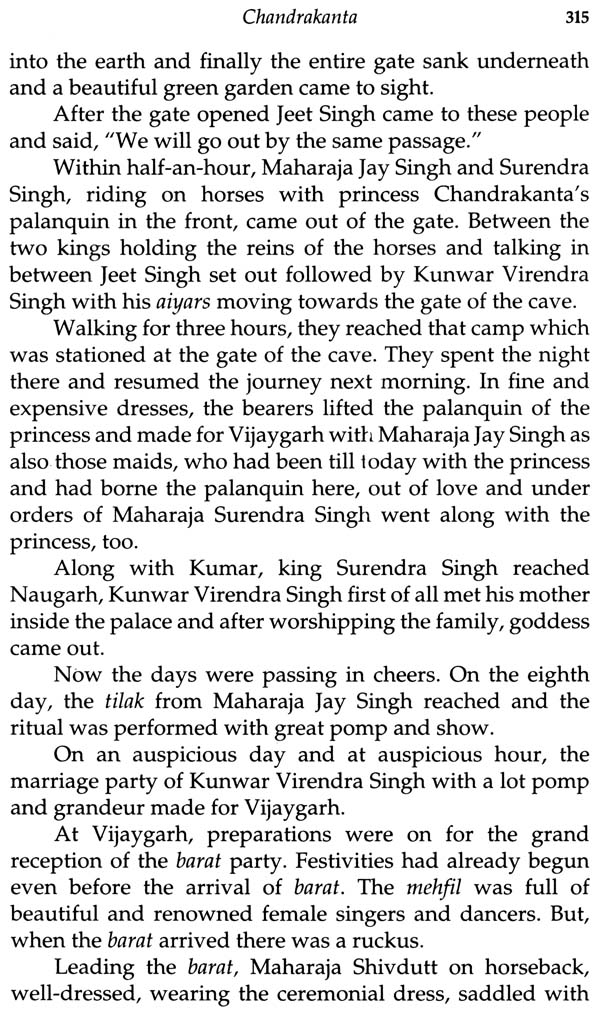
Chandrakanta
Book Specification
| Item Code: | NAQ754 |
| Author: | Devaki Nandan Khatri |
| Publisher: | Prabhat Prakashan, Delhi |
| Language: | English |
| Edition: | 2018 |
| ISBN: | 9789352667383 |
| Pages: | 320 |
| Cover: | PAPERBACK |
| Other Details | 8.50 X 5.50 inch |
| Weight | 300 gm |
Book Description
Devaki Nandan Khatri's Chandrakanta is the virtual Taj Mahal in Hindi fiction, still as much glorious and historical. As the Taj is the emblem of real love, here we have the fictional counter-part. What's more, it is the exuberance of magic and romance, imagination and fantasy, suspense after suspense, battles and wars, espionage and conspiracy, tricks and tact, all blended together to make a sensational love story.
Here we have the aiyars, human beings with extraordinary capacity to transmogrify themselves and take on the appearance of anybody, their voice, their manners and all. Moreover, there is the Tilism, which is a hidden treasure constructed underground with ingenious safeguards and magic locks and entrances. Chandrakanta has the spell of fantasy, a detective novel, a romance per excellence. It can be regarded as the fictional mother of Harry Potter.
Devaki Nandan Khatri (1861-1913) was born in Pusa, Bihar, at the residence of his maternal grandfather, Jivanlal Mahato, a wealthy landowner. His father, Lala Ishvardas, originated from an illustrious family from Lahore. He was widely recognized by his first novel, Chandrakanta, at the age of twenty-six. He subsequently set up his own printing press, the Lahari Press, in Varanasi. His other popular works include, Chandrakanta Santati and Bhutnath.
The publication of Chandrakanta in Hindi in 1888 caused quite a sensation in the Hindi belt. Its author Devkinandan Khatri became the most popular star and Chandrakanta - a household word. Its popularity prompted the people to learn Hindi to enjoy and appreciate the novel. Even after 128 years now, Chandrakanta still has its glamour and the old after-image. In fact, it is an imperishable work.
The popularity of Chandrakanta accounts for its combination of magic and romance, imagination and fantasy, superstition and the supernatural, ingenious tricks and tact, imaginary mechanical exuberance, suspense after suspense, battles and wars, truce and peace, espionage and revelation, conspiracy and its outcome, etc. It was written in an age when Lewis Carroll's Alice in Wonderland was published in 1865 and Through the Looking Glass in 1871. Both the writers have copiously made use of magic and fantasy. However, Chandrakanta is not a children's classic, it is everyone's choice as the main story is realistic and shows king's rivalry and superiority complex. For self-glorification, they sacrificed thousands of soldiers. The atmosphere smacks of deception and fraud, conspiracy and terror, servitude and helplessness.
The main story in Chandrakanta centres around the love and struggle of Prince Virendra Singh of Naugarh and Chandrakanta, the princess of Vijaygarh. He has to face a rival Krur Singh, the son of the Diwan of Vijaygarh. Krur Singh aligns with the king of Chunar, Shivdutt and raises obstacles between Prince Virendra Singh and I have been helped in this task by my nephew, Sri Gobind Lal Shah, retired District Inspector of Schools, Srinagar and Chandrakanta, which ultimately unites the lovers, and Krur Singh dies. What attracts the reader most is the way the story is told in a series of episodes all interlocked. There are the aiyars, human beings with extraordinary capacity to run fast and fight, have knowledge of herbs and their medical application, are cunning spies and good musicians. Even more importantly, the aiyars can transmogrify themselves, i.e., completely change their appearance and take on the appearance of anybody, their voice, their manners and all.
Then there is the Tilism which is a hidden treasure constructed underground with ingenious safeguards and magical locks and entrances. In days of old, when a king had no heir, he consulted astrologers who predicted that there would be a prince illustrious enough to deserve his wealth. The king would then get a Tilism built and fill it with all his wealth. The Tilism had magical doors and fixtures, ferocious looking unearthly guards and layer after layer of safety. The key to the secret chamber lay in a book which was destined to go to the deserving prince and none else. He would ultimately break the Tilism, possess all the wealth and marry the princess. The Tilism reminds one of All Baba's secret cave but here there are caves under caves and a whole household with buildings, gardens, orchards, ponds, housemaids and furnishings.
The creation of Tilism and aiyars in the novel is all together new and different from other like creations in other literatures. Devakinandan Khatri's aiyar cannot only take on the appearance of any male or female, he can perform his or her role in all respects. He can fight, conspire and their astrologer can even foretell the future through his astrological device called ramal. The aiyars also act as a detective whose bag is equipped with magical herbs to etherise someone and revive his consciousness as well. Moreover, they are honest and loyal to their masters.
The novel Chandrakanta, though unique in its own right, was a tremendous feeder to public choice so long attuned to the stories of Arabian Nights and the contemporary trend of the detective novels like those written by Gopal Ram Gahmari and Kishori Lal Goswami. Chandrakanta is, at once, a detective novel, a fantasy and a realistic romance. On the one hand, the novel shows true and passionate love and, on the other, it shows its sustenance even at the cost of one's life as Kunwar Virendra Singh is going to kill himself jumping from the cliff having heard of the death of Chandrakanta. The novel also guards the reader against cheating and fraud. Appearances in many cases are only deceptive and intriguing. The author's skill lies in his super-duper art of creating a very complicated story charged with magic, suspense and coincidence. The main story of love and the pangs of separation is at times pushed back and forth to emerge as the all-motivating force. In passing, the writer presents the exotic beauty of the hills, forests, valleys and hideous caves which is, no doubt, a tribute to the imagination and fancy of Devkirandan Khatri. Today, he may be regarded as the fictional n- other of Harry Potter.
**Contents and Sample Pages**
